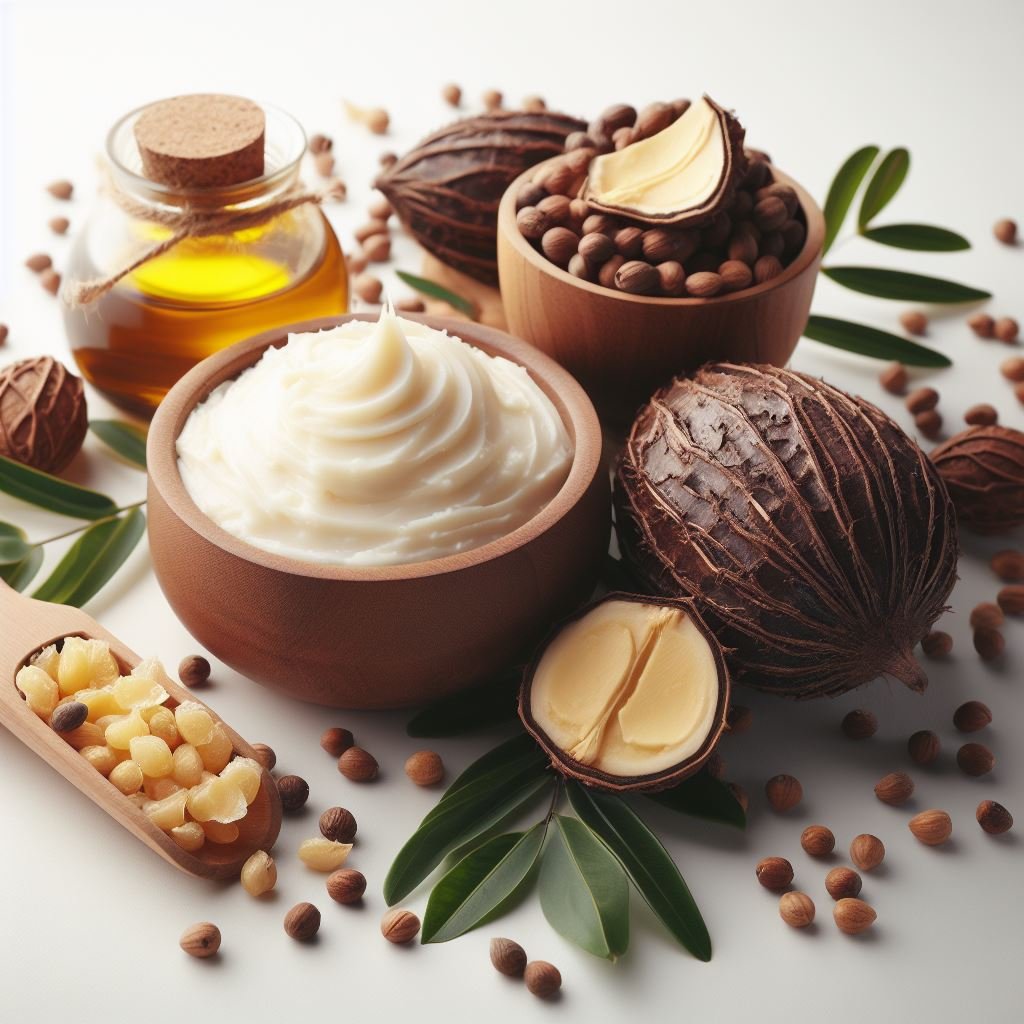Discover the Versatility of Shea Butter: Your All-in-One Beauty Ally
“Discover the natural wonders of shea butter, a skincare powerhouse derived from the seeds of the African shea tree. Packed with vitamins E and A, along with antioxidants, shea butter provides deep hydration, reduces inflammation, and promotes skin elasticity. Embrace the benefits of this natural treasure for a radiant and healthy complexion. Learn how to incorporate shea butter into your skincare routine and explore its transformative effects on your skin, leaving it nourished and glowing.”
What Is Shea Butter ?
• The Shea tree, known as the “Tree of Life” due to its ability to address numerous skin, hair, and health conditions, has earned a nickname. “Nature’s Hair Conditioner” is another alias bestowed upon this marvel Butter for its exceptional moisturizing and softening properties.
• Shea Butter is derived from the seeds of the Shea Tree’s fruits.
• When topically applied, this miracle Butter nourishes the skin, enhancing its clarity and addressing issues such as dryness, spots, dark patches, discoloration, cracks, and wrinkles without clogging pores.
• Used in hair care, it moisturizes and nourishes from root to tip, protecting against dryness and brittleness while repairing without leaving residue.
• In massages, Shea Butter Oil supports skin elasticity and flexibility, increases collagen production, promotes cell renewal, and enhances circulation.
• Shea Butter prevents the retention of bacteria causing irritation and acne, relieves nasal congestion, creates a barrier protecting the skin from harsh environmental factors, and facilitates easy maintenance.
CULTIVATION AND HARVESTING OF QUALITY SHEA BUTTER
Shea trees are native to the Savanna regions of West Africa, where approximately 500 million of them grow wild from Senegal to Sudan. Despite efforts to cultivate the tree in other regions, these attempts have so far been unsuccessful. Shea trees typically begin producing large, green, plum-like fruits when they are 10 to 15 years old, reaching full bearing potential between the ages of 20 and 50. With a known lifespan of up to 200 years, the tree continues to bear fruit throughout its existence.
Shea trees usually start flowering between February and March, from the end of winter to the beginning of spring. The green fruit matures to a brown color, usually between June and July in the summer months. From this point onwards and entering the fall, Shea fruits naturally fall to the ground, allowing for a manual harvesting system. About 30% of the nuts remain on the ground to germinate and contribute nutrients to the soil. A Shea tree can produce 15-20 kg of fresh Shea fruit, yielding 3-4 kg of dry seeds containing 42-48% fat (butter).
Immature Shea fruits have an outer layer called Epicarp, which is a light green covering protecting the fleshy Mesocarp, also known as Pulp. Most Shea fruits contain one or two seeds, but some may have up to three. These edible, oil-rich seeds are used to produce Shea Butter, recognized as a vegetable oil. In the wild, nuts/seeds continue to be utilized by wind, rain, animals, and humans for the future growth of Shea trees.
What Are the Benefits of Shea Butter ?
Super Moisturizing Power
It is an oil with a higher moisturizing capacity than regular creams. To prevent skin dryness, consider incorporating this Butter into your hand and face care routine. During harsh winter conditions, using Shea Butter protects your skin from the wind, maintaining optimal moisture balance.
Alleviates Muscle Aches
With pain-relieving properties, It attracts attention as an oil with analgesic effects. After tiring days, if you experience body and joint pain, applying this oil as a cream on joints can help. Shea Butter has a circulation-boosting effect, easing pain.
Clears Nasal Congestion
If you are in humid areas or going through an illness like a cold, we recommend applying a small amount of this Butter to your nostrils. Shea Butter has a soothing effect on respiration.
Aids in Diarrhea Prevention
It commonly used in the culinary realm, can be consumed to prevent diarrhea. Adding a small amount to water and drinking it helps alleviate the effects of diarrhea.
Clears Blemishes and Acne
It is renowned for its effectiveness in acne treatment. Check the ingredients of specialized acne creams, and you’ll find Shea Butter. It cleans inflammation in acne-prone areas, drying out and eliminating pimples.
Reduces Inflammation
Inflammation at any point in the body deeply affects your health. Shea Butter, with its antibiotic effect, is recommended to address this issue. It shows excellent results in infection treatment.
Restorative for Sensitive Skin
For those with sensitive skin experiencing itching and redness, It is a must-have. Healing irritations on the skin, this butter maintains skin moisture balance and accelerates cell renewal.
Heals Cracks
Cracks on elbows and heels can be discomforting. Shea Butter is known for swiftly repairing cracks, including those occurring after pregnancy. You can treat cracks with this versatile oil.
Nourishes Hair
It also benefits hair! If your hair looks dry and lifeless, applying a this Butter hair mask can show results in a short time. As a nourishing cream, it supports faster hair growth and recovery.
Delays Signs of Aging
It is effective against wrinkles around the eyes and lips. Many choose Shea Butter to alleviate signs of aging. To appear younger, we recommend trying Shea Butter in your skincare routine, including facial masks.

How To Use Shea Butter For Hair
When it comes to using this marvelous butter for your hair, it’s crucial to follow the less-is-more principle. While it might seem straightforward in theory, practical application can present challenges. “Overusing hair products containing shea butter is common, given that it doesn’t spread as easily as oils,” warns our expert. To avoid mishaps, she suggests conducting a patch test before incorporating shea butter into your routine.
If the patch test yields positive results, here’s how you can seamlessly add shea butter to your hair care regimen:
- Opt for a Shea Butter Styling Product:
To shield your hair from breakage and lock in moisture, consider investing in a styling product enriched with this fabulous butter. - Blend with Other Products:
For a personalized hair treatment without much hassle, blend shea butter with your regular conditioning products. This concoction works wonders in smoothing hair, eliminating frizz, tangles, and dullness. - Use as a Hair Mask:
For a convenient and mess-free application, use shea butter as a weekly hair mask in the shower. Rinse it out afterward, and ensure you wash your hair with products designed for deep cleaning to prevent buildup.

How to Make a Hair Cream with Shea Butter?
In its natural state, shea butter can be somewhat firm. Whipping it not only makes it easier to extract from the container but also facilitates smooth application to the hair. You can enhance whipped shea butter by incorporating carrier ingredients such as coconut oil to prevent it from hardening again.
Once whipped, you’ll have a fluffy, ultra-moisturizing natural product that imparts a healthy sheen to your hair. Follow our expert’s step-by-step guide for a DIY whipped shea butter experience.
Ingredients:
- 2 oz. shea butter
- 1 tbsp. coconut oil
Directions:
- Scoop out the shea butter from its jar or container and place it in a glass or metal bowl.
- Boil a small amount of water in a pot. Once boiling, remove it from heat and position the shea butter bowl over the pot. The shea butter will melt quickly, so it’s crucial to remove the pot from heat promptly. Alternatively, you can microwave the shea butter in a microwave-safe bowl, but be aware that this method may result in nutrient loss.
- Remove the bowl from the pot and add the coconut oil to the melted shea butter. Mix thoroughly. (Note: It’s acceptable if the shea butter isn’t entirely liquid; the whipping process will eliminate any butter chunks).
- Utilize a standard hand-held mixer to whip the shea butter/coconut oil blend at medium-to-fast speed for about 20 minutes (short breaks during mixing are permissible).
- After approximately 20 minutes of whipping (or longer for larger quantities of shea butter), your mixture should be light, fluffy, and thick, resembling meringue. Store the shea butter in a cool, dark place in either a glass or plastic container. Avoid refrigeration as it may result in a grainy texture. Natural shea butter combined with coconut oil or jojoba oil typically lasts around six months to a year.
Tip:
Whipping shea butter will increase its volume by two to three times, so ensure you have a container on hand to accommodate the expanded quantity. This ensures a hassle-free experience during application.

How To Use Shea Butter For Skin
In today’s world, natural and organic skincare is becoming increasingly popular. Avoiding chemical-laden products is a crucial step in keeping your skin healthy and radiant. Shea butter is a natural and nourishing ingredient used in skincare. In this article, you will discover the benefits of shea butter in skincare and how to make your own shea butter skincare cream at home.
Benefits of Shea Butter in Skincare:
- Intensive Moisturization: Shea butter penetrates the skin deeply, providing long-lasting moisture.
- Enriched with Antioxidants: Shea butter is rich in antioxidants that prevent aging, keeping your skin youthful and healthy.
- Reducing Skin Inflammation: With anti-inflammatory properties, shea butter can reduce inflammation on the skin.
- Enhancing Elasticity and Softness: Nourishing the skin, shea butter promotes elasticity and helps achieve a smooth texture.

DIY Shea Butter Cream For Healthy Body
Ingredients:
- 1/2 cup pure shea butter
- 2 tablespoons coconut oil
- 1 teaspoon vitamin E oil
- A few drops of lavender oil (optional, for a pleasant fragrance)
Instructions:
- Melt shea butter using a double boiler.
- Transfer the melted shea butter to a bowl and add coconut oil. Mix well.
- Add vitamin E oil to the mixture and stir thoroughly.
- Finally, add lavender oil if desired and mix again.
- Transfer the mixture to a glass jar and let it solidify at room temperature.
Conclusion:
Shea butter is a natural and effective skincare ingredient. By making your own shea butter skincare cream at home, you can nourish your skin and achieve a healthy appearance. This chemical-free cream not only protects your skin but also offers an environmentally friendly option.
We hope this article guides you on shea butter skincare and the homemade cream recipe. Consider incorporating shea butter into your skincare routine to highlight your natural beauty.

